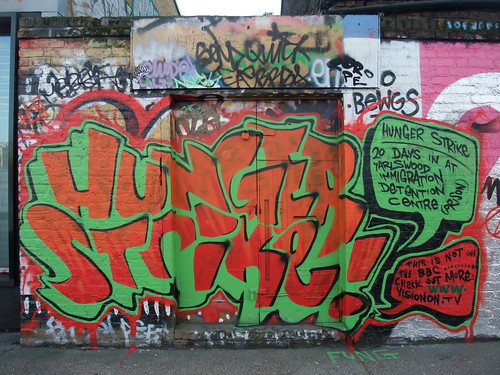On December 28, 1977, Liliana Fontana gave birth to a boy. At the time Liliana and her partner Pedro Sandoval were prisoners in the torture center known as the Athletic Club. This was Buenos Aires during the Dirty Wars. Liliana and Pedro were deemed subversives, and so, at birth, the infant was turned over to the military, and Liliana Fontana and Pedro Sandoval disappeared: “Delia Barrera, held for 92 days, remembered the young couple….Two clear recollections haunt her — how Fontana and Sandoval quietly sang love songs to each other and how on Nov. 4, 1977, the day Barrera was transferred from the center, Fontana hugged her goodbye. `She gave me a kiss, and I could feel her pregnancy,’ Barrera said.” This story was reported two weeks ago. Since then, I have been thinking of Liliana Fontana giving birth, surrounded by torturers. Followed by decades of silence, her screams fill the air.
I have thought of Liliana Fontana while reading about the women prisoners on hunger strike in Yarl’s Wood Immigration Removal Centre, outside Bedford, in the east of England.
In 2003, the British government created something called the Detained Fast Track Asylum System. Here’s how the UK Border Agency, UKBA, describes the system: “Our objective is to fast-track asylum decisions, remove those whose claims fail and integrate those who need our protection. We have succeeded in closing the gap between the number of failed asylum applicants and the number removed. The Government has dramatically cut asylum claims since their peak in 2002. There were fewer claims for asylum in 2006 than in any year since 1993. In the fourth quarter of 2006, 3,665 principal applicants were removed from the country. We have successfully met the Prime Minister’s ‘tipping the balance’ target for the whole of 2006, by 3% (450 people), breaking records for the number of failed asylum seekers successfully removed. In 2007 we introduced a new process for reviewing and deciding asylum cases and we are on target to conclude 40% of cases within six months of receiving the application. By 2011 we aim to complete 90% of cases within six months.” According to the government, the program is a model of efficiency.
According to women asylum seekers, and the children who accompany them, the truth lies elsewhere. In the silence and the screams of a place in which their deaths would count for nothing. That place is Yarl’s Wood.
Here’s how DFT works. A woman applies for asylum. In two or three days, her claim is decided. In 2008, 96 percent of claims were refused first time out. Then, the woman has two days to appeal. The appeal has to be heard within 11 days. Once the woman has applied and failed, while she is `appealing’, she stays in detention at Yarl’s Wood. In 2008 91% of the appeals were refused.
It’s a lousy system for everyone, but for women, it’s loaded and lethal. Women’s cases are often more complex because so many of them involve sexual violence and because many involve family members and partners. If an English woman is raped, the courts understand that the trauma of rape creates feelings that inhibit women from going straight to the police. A woman seeking asylum, however, is expected to reveal all, instantly, to strangers. Delay in revelation is read as duplicity. It’s the logic of the fast-track efficiencies.
Here’s what happens at Yarl’s Wood: “Once in the DFT procedure, women are on a fast-moving treadmill with structural features inhibiting or even preventing them from making their cases effectively. When women arrive at Yarl’s Wood, they will often have their asylum interview the next day. Most only have an opportunity to consult their duty solicitor in a short conversation over the phone. There is little opportunity to build trust, and women, especially in cases involving rape or abuse, may only reveal relevant information late in the process, or not at all. There is limited opportunity to access expert evidence, such as medical reports. The UKBA officer who conducts the asylum interview, known as the case owner, decides whether or not asylum should be granted.”
Since May 2005, over 2000 women have been detained. They have been subjected to programs of efficiency at least twice over. First, there’s the DFT itself. Then, Yarl’s Wood is run by Serco plc. Serco is quite proud of its work at Yarl’s Wood. They “are committed to developing the centre into a recognised centre of excellence for detaining females and families in a safe and secure environment.”
The women prisoners don’t see it that way. Women currently on hunger strike at Yarl’s Wood include: Denise McNeil, 35 year old Jamaican asylum seeker; Mojirola Daniels, Nigerian asylum seeker; Leila, Iranian asylum seeker; Victoria Odeleye, 32 year old Nigerian asylum seeker. They report torture, rape, starvation, other forms of abuse. They talk of the devastating impact of Yarl’s Wood on imprisoned children, such as 10-year-old Egyptian Nardin Mansour. They mourn and protest the suicides as they explain that Yarl’s Wood is intent on killing them. As Laura A, a Sierra Leonean and former Yarl’s Wood prisoner, noted: “I am a fighter, I am used to fight to live, but to be told, ‘You faked your life,’ is a little like death.”
The Yarl’s Wood women hunger strikers have taken the calculus of the killing and turned it on its head, have said they are better than that, they are women, fighters used to fighting, peacemakers used to making peace, and no one decides that it is right for them to be slaughtered. From the Dirty Wars to today’s Efficiency Wars, women prisoners call out, shout, scream. Will the response this time, again, be decades of silence?
(Photo Credit: Mermaid99, Flickr.com)

